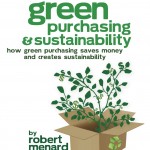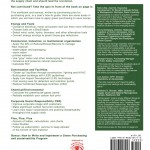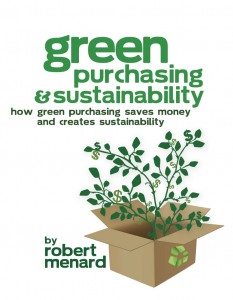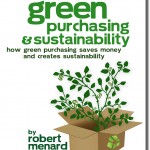
Robert Menard, Certified Purchasing Professional, Certified Professional Purchasing Consultant
These individual endorsements are all from practicing purchasing and supply chain professionals. Here is what they have to say about the importance of this workbook and manual, Green Purchasing and Sustainability which will be available to order in July 2011.
Nick Little, Asst Dir, Executive Development, Eli Broad Graduate School of Management, Michigan State University “Sustainability is critical to business success both now and in the future. This book impressively compiles both the “what” and the “how to” into an indispensable guide that brings together academic concepts and tactical solutions in this emerging arena.”
Gerry Dempsey, Director, Materials Logistics at Vector Aerospace, former Director – Procurement & Contracts at Vancouver Organizing Committee for the 2010 Olympic and Paralympic Winter Games “ “Robert’s cost savings expertise will serve you well. He shows clearly, forcefully, and undeniably that sustainability is all about saving money, reducing consumption, and thus costs. His chapter on construction will help any growing business. This book brings huge ROI to a huge gain to the bottom line.”
George Parson, Purchasing Manager at Tutor-Saliba Corporation “This book drives home the practical value of gong green in the face of a skeptical audience. Bob Menard has written the definitive work on sustainability that serves the entire purchasing profession.”
Lori Averso, CPP, Director Operations at Aeropostale “The only resource you’ll need to gather enormous cost savings and sustainability gains.”
Matthew D. Blondin, MBA. Director of Supply Chain and Materiel Management, Aerojet, Redmond, WA “Going green” means many different things to many people. For years Robert has been inspiring our profession as to “creating Green” for our companies’ bottom line. We share the view that Supply Chain is a profit center. I’m thrilled he continues to challenge us to utilize our talents in connecting sustainability with our procurement and logistics organizations. It’s time to stop talking about it and start doing it ! For the supply chain pro this book is a must read and a call to action – driving profits into our organizations at overall lower costs – both on and off the balance sheet.”
Mary E. Walker, MBA, CISM, A.P.P., CPP, CPPM, CISCM. CIPTC, CIPM, DTM, former Inventory Manager, Buyer, Hagemeyer North America “This book will take its place among beside the very few giants published about the purchasing profession. Even the most complex and seemingly unrelated ideas are translated to practical, useful, and always money saving results”
Shawn M. Scheffler, Strategy Manager–Instructor Development / H&R Block and former Program Manager, American Management Association “Robert is a veteran pro at designing instructional content. He takes complex and mysterious problems down to street level where solutions are applied. This book is his latest masterpiece”
 Michael Colvin, Consultant at Resources Global Professionals, former Director, Procurement at Dell Perot Systems “The chapter on energy is jam packed with charts and calculations that provides the know-how necessary to prove sustainability. The physics and engineering is presented in a user friendly form that can be applied in any professional workplace.”
Michael Colvin, Consultant at Resources Global Professionals, former Director, Procurement at Dell Perot Systems “The chapter on energy is jam packed with charts and calculations that provides the know-how necessary to prove sustainability. The physics and engineering is presented in a user friendly form that can be applied in any professional workplace.”
Nicholas Teklu, Six Sigma Black Belt, CPP, CPPM, CISM “As a Six Sigma Black Belt, CPP, CPPM and CISM, cost savings and waste avoidance is of greatest interest. He has done a masterful job in crafting a sustainable plan that is a template for any business.”
Tony Hinds, Sr. Director, Supply Chain Management at El Centro Medial Center, former Corp. Director at Baylor Health Care System and VP Strategic Sourcing at Parkland Hospital “This singular combination of skills, experience, and knowledge has created this authoritative manual that serves the entire purchasing profession. Menard has blazed the path to lead the sustainability and green purchasing revolution.”
Steve Hague, Supplier Services Manager, Citizens Financial Group. “Bob brings his expert knowledge of Purchasing and Negotiation to this area of untapped profit potential. If your responsibilities include Purchasing or Facilities Management, get this book now! It’s full of practical and easily understandable advice and tips on how to save money and contribute to the new Green revolution!”
Gary Beaudreau, Sr., Director, Supply Chain Management, Xcellerex, Inc., formerly Global Indirect Sourcing Leader at GE “This book helps every organization to save money and go green in the process. No other work goes to such great lengths to connect sustainability with procurement. For every supply chain pro, this is the ultimate musts read and apply.”
Nate Brown, Buyer at Bio-Rad Laboratories, formerly Operations Officer at US Army “This thoroughly researched reference manual shows how to create a bona fide sustainability initiative through green purchasing. Robert’s systematic process eliminates greenwashing and drives sustainability while cutting cost and overhead. This is not a quick fix solution but an iterative process that produces incontrovertible sustainability gains.”
Scott Heilman, Materials Manager at Sinclar, formerly Inventory Data Analyst-Supply Chain Consultant at Logic PD “Menard is a proven expert in the purchasing profession. This manual is his latest contribution to business leadership.”
Ann Unsworth, Senior Buyer, Qualex, Inc “This is a must read for every business pro; these pages contain the wisdom and know how that can be applied to advance sustainability and earn huge savings in the process.”
Jim Gomes, CPSM and PMP, former VP Administration at ISM Dallas “This book is exactly what the purchasing profession needs to convert good intentions into sustainable gains and attendant cost savings”
Mike Wilberg, Retail Business Analyst at Johns Manville “Every chapter is filled with tips, advice, techniques, and provable methodology to bring your sustainability program to and advanced level.”
Carol Ford, Contract Specialist at U.S. Mint Philadelphia “With such conflicting advice on how to purchase green and feel confident about it, Robert Menard’s book is a must-buy for any purchasing professional/department. It presents sustainability issues clearly and concisely; after reading the book and doing the exercises, you can become the ‘go-to’ person in your organization for green purchasing/sustainability”.






